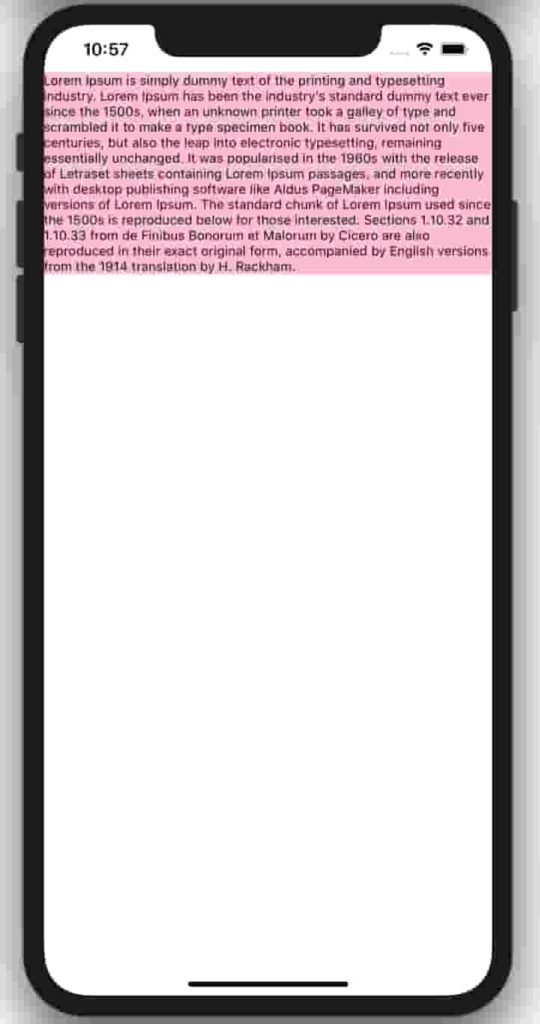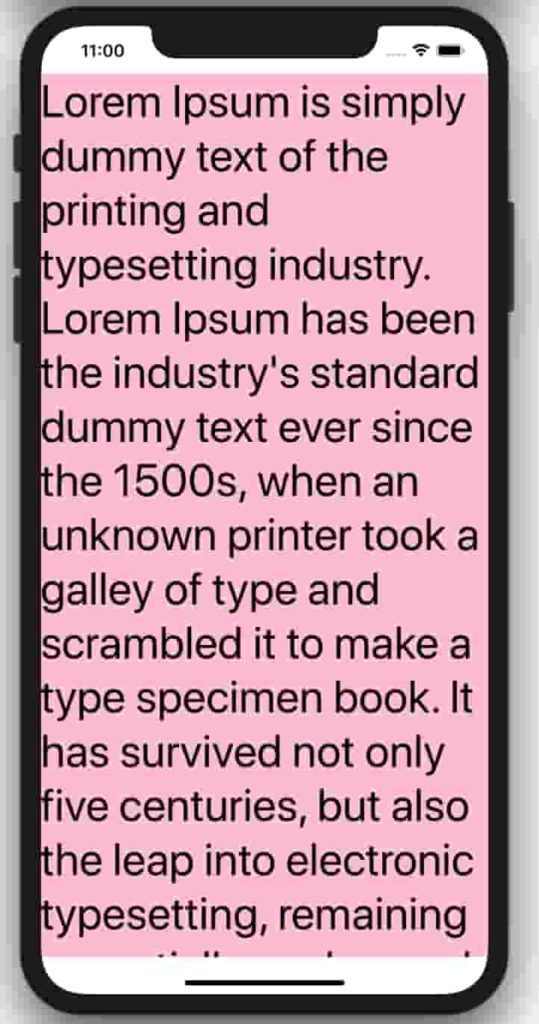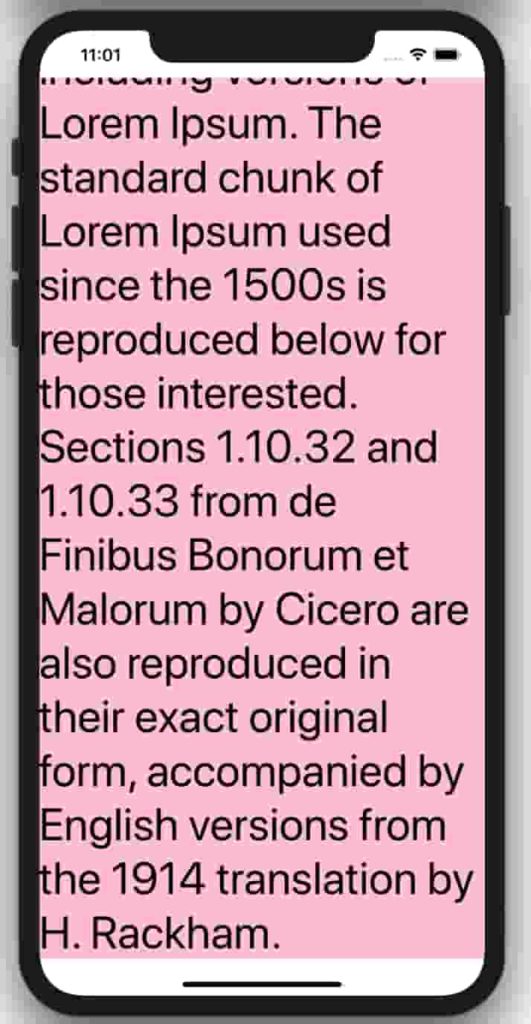環境・条件
- React Native の初心者向け
- Expo 開発環境:v36.0.2
- ScrollView を関数コンポーネントで実装します。
手順
App.js を以下のように作成し、設定を追加していきます。
// App.js
import React, { memo } from "react";
import { View, Text, StyleSheet } from "react-native";
const App = () => {
return (
<View style={styles.container}>
<Text>App</Text>
</View>
);
};
const styles = StyleSheet.create({
container: {
flex: 1,
alignItems: "center",
justifyContent: "center"
}
});
export default memo(App);
スクリーンの高さとコンテンツの高さで判断するのがポイントです。
- Step 1コンテンツの最下段までスクロールできるように。
以下は、
ScrollViewをSafeAreaViewでラップして使う前提です。SafeAreaView の style に
{flexGrow:1}を追加します。
※{flex:1}に設定するとコンテンツの最下段が見えなくなります。// App.js import React, { memo } from "react"; import { Text, StyleSheet, SafeAreaView, ScrollView } from "react-native"; const App = () => { return ( <SafeAreaView style={styles.container}> <ScrollView contentContainerStyle={styles.scrollView}> <Text>App</Text> </ScrollView> </SafeAreaView> ); }; const styles = StyleSheet.create({ container: { flexGrow: 1 }, scrollView: { backgroundColor: "pink", alignItems: "center", justifyContent: "center" } }); export default memo(App); - Step 2コンテンツの高さを取得します。
onContentSizeChangeprops を利用します。ハンドラー関数 (
handleContentSizeChange) を作成し、デフォルトでパラメーターとして渡されるcontentWidth、contentHeightの中で高さ (contentHeight) だけを利用します。ScrollViewにonContentSizeChange={handleContentSizeChange}を追加します。<ScrollView onContentSizeChange={handleContentSizeChange} // 追加 ... >取得したコンテンツの高さを State (
ctxHeight) に保存します。import React, { memo } from "react"; import { SafeAreaView } from "react-native"; ... const [ctxHeight, setCtxHeight] = React.useState(0); const handleContentSizeChange = (contentWidth, contentHeight) => { setCtxHeight(contentHeight); };↓↓
// App.js import React, { memo } from "react"; import { Text, StyleSheet, SafeAreaView, ScrollView } from "react-native"; const App = () => { const [ctxHeight, setCtxHeight] = React.useState(0); const handleContentSizeChange = (contentWidth, contentHeight) => { setCtxHeight(contentHeight); }; return ( <SafeAreaView style={styles.container}> <ScrollView contentContainerStyle={styles.scrollView} onContentSizeChange={handleContentSizeChange} > <Text style={styles.text}>App</Text> </ScrollView> </SafeAreaView> ); }; const styles = StyleSheet.create({ container: { flexGrow: 1 }, scrollView: { backgroundColor: "pink", alignItems: "center", justifyContent: "center" }, text: { fontSize: 42 } }); export default memo(App); - Step 3スクリーンの高さを取得します。
Dimensionsか、useWindowDimensionsフックを利用して取得できます。// Dimensions import { Dimensions } from "react-native"; const {width, height} = Dimensions.get('window')// useWindowDimensions import { useWindowDimensions } from "react-native"; const ScrollViewExampleScreen = () => { const window = useWindowDimensions(); ...ここでは
useWindowDimensionsのwindow.heightを使用します。 - Step 4Scroll 機能を ON / OFF します。
scrollEnabledprops にコンテンツの高さが大きい時だけにtrueになるように設定します。... const scrollEnabled = ctxHeight > window.height; ... <ScrollView scrollEnabled={scrollEnabled} // 追加 onContentSizeChange={handleContentSizeChange} > ... - Step 5動作を確認します。
<Text style={styles.text}>App</Text>に長いテキストを適宜追加してからテストを行います。※ テスト方法:(
StyleSheet内 )
1)containerのflexGrow→flex→flexGrowに変更しながらテスト、
2)textのfontSizeを 42 → 12 → 42 に変更しながらテストします。↓最終版
// App.js import React, { memo } from "react"; import { StyleSheet, Text, ScrollView, SafeAreaView, useWindowDimensions } from "react-native"; const App = () => { const window = useWindowDimensions(); const [ctxHeight, setCtxHeight] = React.useState(0); const handleContentSizeChange = (contentWidth, contentHeight) => { setCtxHeight(contentHeight); }; const scrollEnabled = ctxHeight > window.height; console.log("-----------------------"); console.log("!@# window.height: ", window.height); console.log("!@# contentHeight: ", ctxHeight); console.log("!@# scrollEnabled: ", scrollEnabled); return ( <SafeAreaView style={styles.container}> <ScrollView scrollEnabled={scrollEnabled} onContentSizeChange={handleContentSizeChange} style={styles.scrollView} > <Text style={styles.text}> Lorem Ipsum is simply dummy text of the printing and typesetting industry. Lorem Ipsum has been the industry's standard dummy text ever since the 1500s, when an unknown printer took a galley of type and scrambled it to make a type specimen book. It has survived not only five centuries, but also the leap into electronic typesetting, remaining essentially unchanged. It was popularised in the 1960s with the release of Letraset sheets containing Lorem Ipsum passages, and more recently with desktop publishing software like Aldus PageMaker including versions of Lorem Ipsum. The standard chunk of Lorem Ipsum used since the 1500s is reproduced below for those interested. Sections 1.10.32 and 1.10.33 from de Finibus Bonorum et Malorum by Cicero are also reproduced in their exact original form, accompanied by English versions from the 1914 translation by H. Rackham. </Text> </ScrollView> </SafeAreaView> ); }; const styles = StyleSheet.create({ container: { flexGrow: 1 }, scrollView: { flex: 1, backgroundColor: "pink", alignItems: "center", justifyContent: "center" }, text: { fontSize: 42 } }); export default memo(App);

・window.height: 896
・contentHeight: 186.333328
・scrollEnabled: false

・window.height: 896
・contentHeight: 2155.33325
・scrollEnabled: true

・window.height: 896
・contentHeight: 2155.33325
・scrollEnabled: true
まとめ
React Native で ScrollView を使うときは parent に {flexGrow:1} を設定することでiOS/Android 両方スクロールが正常に動作します。
コンテンツの高さとスクリーンの高さを比較することで、スクロール機能を必要な時だけ ON にすることができました。



コメント